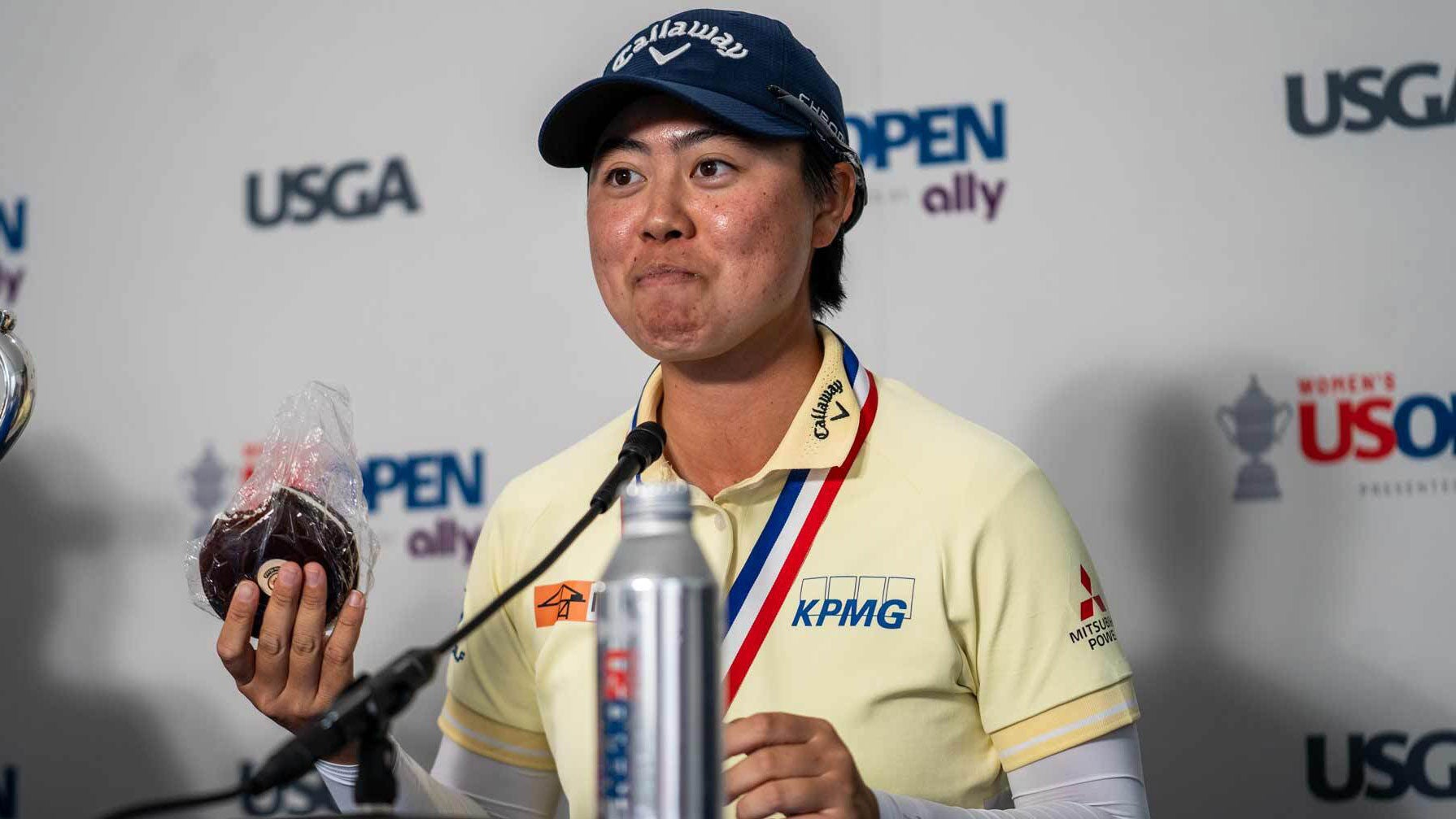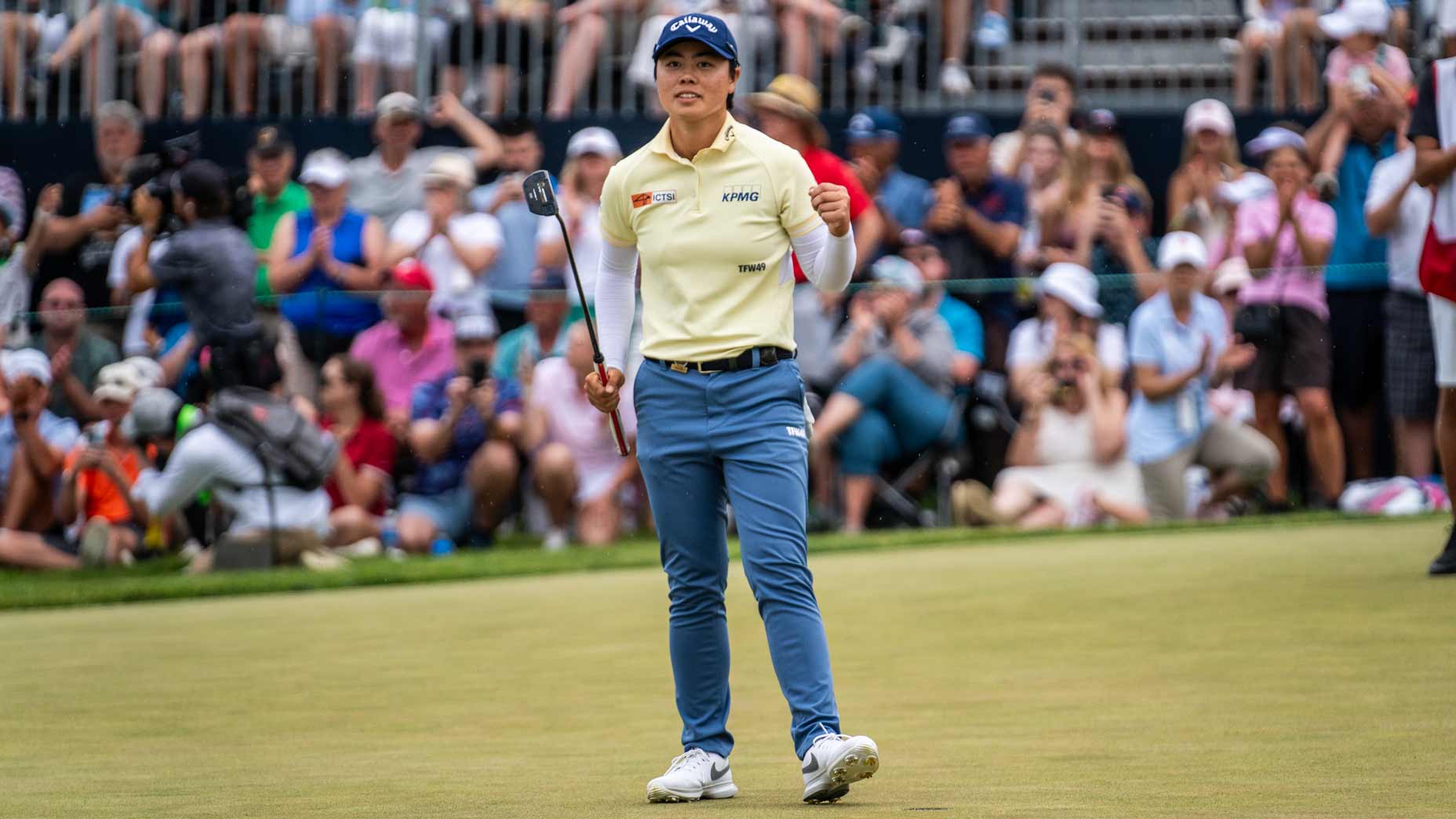The other winner at U.S. Women’s Open didn’t hit a single shot
- Share on Facebook
- Share on Twitter
- Share by Email

Rose Zhang on Lancaster CC's elevated 3rd tee last week.
getty images
LANCASTER, Pa. — We crave intimacy. The corner bar, the corner table, the famous nook at Augusta National, Amen Corner, where the 11th green, the wee par-3 12th and the 13th tee share a lawn. And that was part of the magic of this U.S. Open at the Lancaster Country Club. It was intimate.
Before he headed out for the awards presentation, Mike Whan, the USGA’s CEO, stood in a roomful of players, caddies and family members and asked in a voice loud enough to be heard above the din, “Does anybody know how to pronounce Dylan Vallequette? The last thing I’d want to do is go out there and say it wrong.”
The winner’s caddie, and Whan had it right. Val-ah-ket. The winner takes home a gold medal that depicts Mickey Wright’s sweet swing just beyond impact and at the height of her powers. Wright won four U.S. Opens. Yuka Saso has now won two. The winning caddie takes home a plate. Golf, at its best, has to do the big things right, but the little things are huge, too. A medal you can put in your backpack. A plate you can put in your suitcase. A long surname pronounced correctly at an awards ceremony.
Some minutes earlier, an LCC bartender found her eyes welling when Saso, in a TV interview, noted the sacrifices her family had made for her golf. “It makes me emotional,” the barkeep said, to no one in particular. She had seen the golfers come and go all week. The players got to know the staff and the staff got to know the players. Golf at its best is intimate.
On Monday, Memorial Day, Minjee Lee turned 28 and the next night she celebrated her birthday with one of her closest friends on the LPGA tour, Wei-Ling Hsu, 29, from Taiwan. (Wei-Ling is 5-foot-2 with a swing-by-God.) They went out for dinner at an earth-to-table restaurant in a small brick inn, the Lancaster Arts Hotel, in beautiful downtown Lancaster. For their dessert course they shared a bowl of crème brulee lighted by a single candle.
Five days later, Wei-Ling was holing out on 18, wrapping up her eighth U.S. Open. And behind her, a wedge shot away, Minjee was teeing off on Lancaster’s 10th tee. Members and guests were spilling out of different clubhouse perches and its verandah to steal a look. The 10th tee and the 18th green were ringed by fans. The circus had come to town. Lancaster was living large, in its cozy way.
Wei-Ling was watching on an outdoor TV when Minjee made a this-kills-it double on the par-3 12th. Her tee shot went in the creek and Wei-Ling groaned. Wei-Ling’s top-25 finish was a step in the right direction, for her. She had missed both cuts in the two New Jersey LPGA stops in May. Minjee’s tie-for-9th finish was a major disappointment. She was tied for the lead with two others through 54 holes in this 79th U.S. Women’s Open. She closed with a 78. A good golf course is harder than it looks. Enter Lancaster Country Club, right when golf needed it. The greens, for one thing. You couldn’t stop the ball near the hole. Good tournaments turn on little things.
It was all just so lovely, even if the scoreboard totals looked like they were time-traveled in from 1964. (Golf is supposed to be hard, and U.S. Open golf especially so!) The course. The maze of rooms that is the clubhouse. The three-mile drive, from downtown to the club’s front gate, horse-and-buggies, now and again, in the shoulders of the roads, $20 lawn parking in the neighborhood by the course, kiddie entrepreneurs selling lemonade for a buck a cup.
She won the U.S. Women’s Open. Her gestures afterward also were tellingBy: Claire Rogers
The USGA had another event in Pennsylvania this spring, the men’s U.S. Amateur Four-Ball Championship at the Philadelphia Cricket Club, which wrapped up the day before the first round of the Women’s Open. It, too, was intimate. There was Blades Brown, 16-year-old golfing sensation from Tennessee. There was Will Wears, who logged many rounds in high school playing alongside his grandfather, Arnold Palmer, on the other side of the state, in Latrobe.
The Cricket Club’s 3rd tee and 11th tee share a rectangle of turf. You can stumble off the 15th green to the 16th tee. The home hole plays downhill over a creek and to the farmhouse clubhouse. It’s a Tillinghast course where golf has been played for a century. The old-time architects built intimate courses. The USGA brings its events to walking golf courses. That’s a necessary starting point.
By Sunday night, Wei-Ling’s caddie, Nicolas Pereira, was spent. Wei-Ling is from Taiwan and her first language is Chinese. Nicolas is from Spain and his first language is Spanish. They do their caddie-player thing in English, so that takes effort. They were on a course where something can go wrong on every shot, and that will grind on you, for player and caddie both. They were playing for a medal and a plate — and a chance to keep doing the thing they do.
Nicolas, a runner, is a study in fitness, so it wasn’t Lancaster’s rolling hills that had him worn out. It was four days of reading swirling winds, the knobs on the greens, his player’s moods. For Wei-Ling, pretty much the same. All these little things. Golf at its best is intimate.
Michael Bamberger welcomes your comments at Michael.Bamberger@Golf.com
Latest In News

Michael Bamberger
Golf.com Contributor
Michael Bamberger writes for GOLF Magazine and GOLF.com. Before that, he spent nearly 23 years as senior writer for Sports Illustrated. After college, he worked as a newspaper reporter, first for the (Martha’s) Vineyard Gazette, later for The Philadelphia Inquirer. He has written a variety of books about golf and other subjects, the most recent of which is The Second Life of Tiger Woods. His magazine work has been featured in multiple editions of The Best American Sports Writing. He holds a U.S. patent on The E-Club, a utility golf club. In 2016, he was given the Donald Ross Award by the American Society of Golf Course Architects, the organization’s highest honor.









